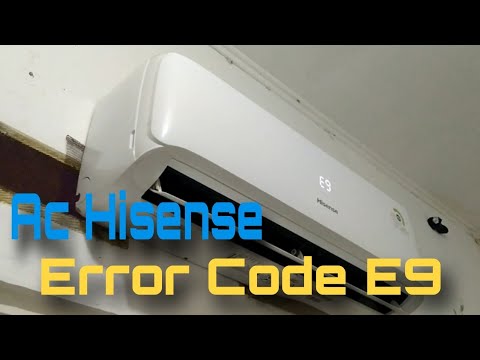Hisense AC E9 Error Code
Your Hisense air conditioner should keep you cool and worry-free, but when an error like E9 pops up, it can be frustrating. Don’t worry! This article will break down what the E9 error means, what causes it, and how to fix it step-by-step in simple terms.
What Is the Hisense AC E9 Error Code?
The E9 error on a Hisense air conditioner typically signals a communication issue between the indoor and outdoor units or a system malfunction. It may cause the AC to stop functioning properly or display reduced cooling performance.
Let’s dive into the nitty-gritty of what’s going on under the hood.
Common Causes of the Hisense E9 Error
Here’s a breakdown of possible reasons for the E9 error:
| Cause | Description |
|---|---|
| Communication Failure | The indoor and outdoor units may not be communicating properly due to wiring issues or faults. |
| Dirty Air Filters | Clogged filters can block airflow, causing system pressure imbalances. |
| Low Refrigerant Levels | Low refrigerant affects cooling performance and can trigger errors. |
| Obstructed Airflow | Blocked vents or intakes cause inadequate airflow, overheating the system. |
| Malfunctioning Sensors | Faulty temperature or pressure sensors disrupt normal operation. |
| Fan Motor Issues | A malfunctioning fan reduces cooling efficiency and may overheat components. |
How to Troubleshoot and Fix the Hisense E9 Error
Let’s troubleshoot the issue step-by-step, starting with the easiest solutions and moving to more complex ones.
Check and Secure All Wiring Connections
Loose or disconnected wires between the indoor and outdoor units are a common culprit for communication issues. Follow these steps:
- Turn off and unplug the air conditioner.
- Open the access panel to check the wires connecting the two units.
- Ensure no wires are frayed, loose, or damaged.
- If wiring looks fine, reconnect and test the AC.
| Tip: If you’re unsure about electrical connections, call a technician to avoid hazards.
Clean or Replace Air Filters
Dirty air filters can restrict airflow and trigger an error. Cleaning them is easy:
- Turn off the AC and remove the filters.
- Use a vacuum or rinse them with water and mild detergent.
- Let them dry completely before reinstalling.
- If filters are worn or heavily clogged, replace them.
| Maintenance Advice: Clean filters every 2-4 weeks during peak usage.
Inspect and Clear Obstructions to Airflow
Blockages around the indoor and outdoor units can reduce cooling efficiency. Check for:
- Blocked air vents or ducts.
- Furniture, curtains, or objects obstructing airflow.
- Dirt or debris around the outdoor condenser unit.
| **Solution Table for Obstructed Airflow: |
| Problem | Action |
|---|---|
| Vents blocked by furniture | Move furniture or objects. |
| Debris near outdoor unit | Clean area around the condenser. |
| Dirty condenser coils | Clean coils using a soft brush. |
Check Refrigerant Levels
Low refrigerant can trigger the E9 error due to pressure imbalances. This requires professional help:
- Contact an HVAC technician to check for leaks.
- If refrigerant is low, they will top it off and repair any leaks.
| Data Table: Effects of Low Refrigerant |
| Symptom | Impact |
|---|---|
| Weak cooling | Poor performance |
| High electricity bills | Overworking of compressor |
| Frost on coils | Imbalance in temperature |
Inspect the Fan Motor
A malfunctioning fan motor can cause overheating and system failures. Here’s what to do:
- Listen for strange noises when the AC runs.
- Check if the fan blades are spinning properly.
- If the motor is overheating or not running, call a technician to repair or replace it.
Reset the Air Conditioner
Sometimes, a simple reset can fix temporary glitches:
- Turn off the air conditioner and unplug it.
- Wait for 5-10 minutes.
- Plug it back in and restart.
- Check if the E9 error disappears.
Test the Temperature Sensors
Faulty temperature sensors can send incorrect signals to the control board. Here’s how to test them:
- Access the sensor (usually near the evaporator coils).
- Clean any dust or debris.
- If the sensor appears damaged, replace it.
| Table: Common Sensor-Related Symptoms |
| Symptom | Possible Sensor Issue |
|---|---|
| Incorrect room temperature reading | Malfunctioning room temperature sensor |
| Unit cycling on and off frequently | Faulty pressure or temperature sensor |
When to Call a Technician
If you’ve gone through these steps and the E9 error persists, it’s time to call in a professional. Here’s a checklist for when to seek expert help:
| Reason to Call a Technician | Why |
|---|---|
| Persistent E9 error after resets | Could indicate a major system fault, like control board failure. |
| Low refrigerant or leaks detected | Requires specialized equipment and expertise to fix. |
| Damaged wiring or loose connections | Electrical hazards require professional handling. |
How to Prevent Future E9 Errors
Preventing issues is always better than fixing them later. Here are maintenance tips:
| Maintenance Task | Frequency |
|---|---|
| Clean air filters | Every 2-4 weeks |
| Check for obstructions in airflow | Monthly |
| Inspect wiring connections | Twice a year |
| Schedule professional servicing | Annually |
By following these maintenance tips, you can prolong your AC’s life and minimize the chances of encountering the E9 error.
Final Thoughts: Don’t Panic—Fixing the E9 Error Is Doable!
The E9 error on your Hisense AC doesn’t have to be a major headache. Start by checking the basics like wiring, airflow, and filters. If things get tricky, call a technician to help. With proper maintenance, you can enjoy cool, comfortable air all year round without any worries!

